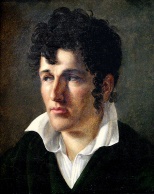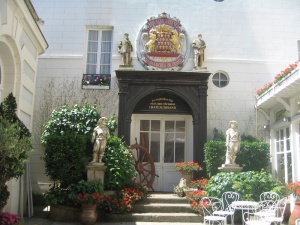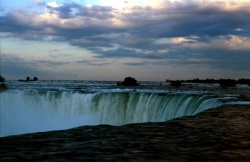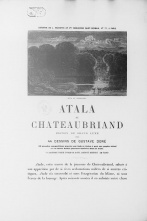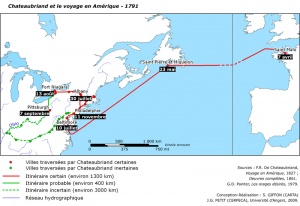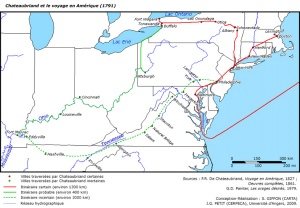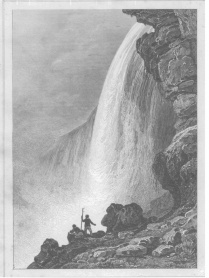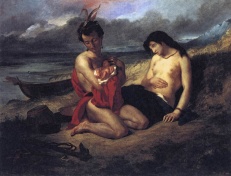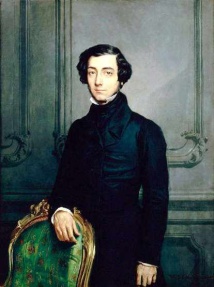French Culture in North America; Chateaubriand’s Travels and Literature
par Petit, Jacques-Guy
Chateaubriand's voyage that took him to the United States and along the Canadian border in 1791 was one of discovery that left its mark on his life's work. His ode to the New World sung in his novels and travel books have made him, in the eyes of generations of 19th century romantics, the "inventor of America" and, more precisely, the one who reinvented Louisiana. In retelling and glorifying the experiences of explorers, missionaries, travellers, and naturalists from the early days of New France to his own times, his works gave numerous generations of Europeans a yearning for the Americas. And so, for these reasons, Chateaubriand should be considered an integral part of French cultural heritage in North America.
Article disponible en français : Amérique française de Chateaubriand : voyage et littérature
Rediscovering French Culture in North America
Chateaubriand had a tremendous influence on the writers and readers of his time. Legions of admirers and lovers, such as Madame Récamier, seduced by the one they called the "charmer" also added weight to his influence. The immense success of his novel Atala, republished five times during the first year, along with variations and unauthorised adaptations for theatre, music, poems, paintings or engravings, not only had the effect of making the author and his taste for wilderness popular, but also French-speaking North America, even though it had been forty years since the British conquest. More than the various "scientific" works, novels and travelogues of the 1801 - 1850 period or even Tocqueville's major study on democracy in America (which wasn't really read much outside of elite circles), Chateaubriand's works had a lasting and widespread influence on the thinking of the entire era. Much more than ordinary literature, it would "shape the general public's knowledge of North America".
The Romantic Writer (1768-1848)
François-René de Chateaubriand was born September 4th, 1768, in Saint-Malo. He spent his youth between the Combourg Castle, colleges in Brittany and his birth place. Born on the Atlantic coast of France, he seemed destined for a life at sea, just like many a Saint-Malo navigator, such as famous Jacques Cartier, whom Chateaubriand admired and considered to be France's own Christopher Columbus. Dreaming of unexplored lands, he wished to convert Canada's "savage" Native peoples to Christianity and to clear its forests. But it was not to be, for his father had obtained a commission for him as a second lieutenant in the Navarre regiment and he became an country landowner in Cambrai in 1786.
Seduced by the new ideas of the [French] pre-revolutionary years, his views are rather closer to J.J. Rousseau's melancholic reveries than to the critical mind of Diderot. But, above all, he was influenced by his visits to the liberal minister Malesherbes, reading everybook of the man's library. At first speaking in favour of the [French] Revolution, the young aristocrat would quickly become disappointed and then frightened by the later developments. He left for North America on April 8th, 1791, but returned quickly on January 2nd, 1792. Later, in May of 1793, he immigrated to London, England for a seven-year exile. There, in 1797, he published his historical, political and moral Essay on revolutions. This work and his philosophical influences are in contradiction with his religious ambitions, which were still vague at the time, but which would eventually assert themselves in his first version of Génie du Christianisme [The Genius of Christianity] published in 1799. The consulate being favourable to facilitating the exiles' return, Chateaubriand returned to France on the spring of 1800 to publish Atala (1801) followed by Génie and René in 1802. His vivid rendering of the New World in his writings, his sentimentalism and his Catholic fervour earned him literary glory, but also the good graces of Napoleon Bonaparte at a time when the Concordat would restore privileged relations between the state and the Church. In May of 1803, he was rewarded with the position of first secretary to the Legation of Rome and was later appointed Minister of France at Valais. He resigned on March 22nd, 1804, after the execution of the Duke of Enghien.
For the years to come, he would have both a literary and a political career, as he worked under the restored royalty. He would be rewarded with a number of honours and responsibilities. First he was appointed minister of Louis the 18th and then Peer of France in 1815. Later he was ambassador in Berlin, then in London (1821-1822) and eventually minister of foreign affairs in 1822. Sometimes considered a political weather cock, moving from ultra-royalist to moderate liberal views, Chateaubriand would leave politics around 1829 - 1830. As for his literary achievements, he also wrote: Les Martyrs (1809), L'Itinéraire de Paris à Jérusalem (1811), Les Aventures du Dernier Abencérage (1826), Le Voyage en Amérique (1827), Etudes Historiques (1831), Vie de Rancé (1841). He published his Complete Works (including Les Natchez) as early as 1826. But his masterpiece, Mémoires d'Outre-tombe, was published only in 1848, soon after his death. His cousin Tocqueville described him as a man from the past with an old-fashioned spirit. But according to Sainte-Beuve, the most famous critic of his time, he more or less fathered the whole modern romantic school.
The Journey to North America (1791) and the North American Tales
If, according to Sainte-Beuve, Chateaubriand was a new Homer, his voyage to North America was his odyssey. He often goes back on the reasons for this journey and it is difficult to sort out his earlier motivations from how he interprets them later. Around 1789, the young United States sparked the interest of the French much more so than Canada, which was at that time under British rule. Like so many of his contemporaries, Chateaubriand had read Saint-John Crèvecoeur's Lettres, which had popularised the stereotype of a prosaically glorious New World full of beautiful, noble savages. While visiting Malesherbes' library, Chateaubriand read Lafitau, La Hontan, Charlevoix, Abbot Raynal, Le Page du Pratz, Carver, etc. He also studied North America's fauna and flora with his mentor. Fascinated by "the customs of the savages", he would have liked to have started to write the "epic tale of man and nature". After having read French, English, Russian, Danish and Swedish writings about the Bering Strait and the great American North, he professed the desire to become more famous than Captain James Cook by discovering the mythic North-West Passage. It would be a new route, following the Canadian Great Lakes, then part of the Mississippi, heading towards Carolina [a territory that went much further inland than today's American states] and following the Pacific shores north to finally come back through the Hudson's Bay and Canada. Having only his meagre fortune and a letter of recommendation addressed to Washington, he hoped to succeed with this chimerical feat. The obvious goal of the journey was more to escape boredom and flee the dangers the French Revolution held in store for aristocrats.
Chateaubriand left Saint-Malo on April 8th, 1791. After putting into port at Île Saint-Pierre, near Newfoundland, he came ashore in Baltimore on July 10th. After having visited New York, Boston and Lexington, he followed Carver's itinerary. He sailed up the Hudson all the way to Albany and then follows the Mohawk Trail to Niagara. He met with Indian tribes in Genesee Country and in Niagara where he remained for a month after having broken his arm. Thereafter, he put aside his dreams of becoming an explorer and in the beginning of September he left the region as a voyageur, heading south and west (or so he lets us believe) towards Ohio, Pittsburgh, the junction of the Mississippi and Ohio rivers and finally the Floridas (the name of Louisiana at the time). But, having learned of Louis 16th's arrest, he left North America on December 10th and arrived in France on January 2nd, 1792. Within five months, Chateaubriand allegedly was to have visited the shores of Ohio and travelled as far as Pittsburgh (although the Natives of the area were rebelling at the time), but he could not possibly have reached the Mississippior the Floridas. Whether last part of the journey is real or not is of little importance because, once having travelled through the American "deserts" (the raw, untamed wilderness of forests, lakes, rivers and savannas), the writer would bring back with him images and impressions that would influence his work. He also brought back a rough manuscript that, with some work, would provide enough material to write Atala, René, Natchez, Voyage en Amériqueas well as three volumes of the Mémoires.
The story of Atala, ou les Amours de Deux Sauvages dans le Désert [Atala, or the Love of Two Savages in the Desert] takes place in Louisiana, before the British conquest. It was an instant success. This Rousseauistic poem about a tragic exotic love, in which religiousity rivals with sentimentalism, fulfilled the public's expectations and thirst for escape, after ten years of social unrest and disillusionment with the revolution. René, first published in 1802 in the same volume as Les Natchez and then in 1805 with Atala, is an autobiography in the form of a novel. The tale takes place in same setting and characters as those in Atala. It portrays the melancholy of passions and the failure of a European who fled society, in order to seek refuge in solitude with the "noble savages".
Voyage en Amérique, published in 1827, more than 35 years after the writer's own voyage, is a heterogeneous work. While reusing his previous works and his borrowing from older documents, Chateaubriand presents himself as a travelling writer that uses his observations to support his work. To pass himself off as a knowledgeable historian, he includes studies and writings published since his own voyage to North America-with which he is quite familiar as co-founder and former president of the Société de Géographie [French Society of Geography], along with secretary Malte-Brun. In addition to the already-mentioned authors, he sometimes makes use of the writings of Bartram, Imlay, Mackenzie, Samuel Hearne, Vancouver and Lewis and Clark. The Voyage has four parts: the first part is a preface that sums up all the historic journeys since the Bible and Homer in a sort of optimistic treatise on human progress. It would seem his knowledge of this era is based almost exclusively on Malte-Brun's Précis de Géographie Universelle. The second is a description of his journey to North America and gives numerous anecdotes and personal reflections. Relatively precise at first, the account of his journey becomes somewhat vague after Niagara; the descriptions of the American West, Louisiana and the Floridas most probably coming from other travellers' notes than from his own memory. This seems even more obvious in the third part, which is devoted to the fauna and flora and to the "savages customs" of the Natives (everyday life, language, religion, government). As for his extensive conclusion, it is a historical, political and statistical study of the United States and the Spanish Republics.
Ode to the New World and Nostalgia for French Speaking North America
Chateaubriand established himself as the eulogist of the New World, fascinated by the American "deserts" and by its populations of "savages". His vivid use of language, despite some stereotypes, brings to life and glorifies his experience of the New World, as well as the documentation he uses. His poetic prose seduces his contemporaries, as it presents the natural man in opposition with civilised man, whose soul has long been caged in cities, but has been crying out for "primitive freedom" and is finally able to declare "I find you at last." Although Chateaubriand reuses Rousseauistic themes from the Age of Enlightenment, he goes even further, for in the tale of 1827, he doesn't even particularly attempt to hide the vices of the Indians now corrupt by colonisation and contact with Europeans. Thus, he re-examines the idea of the American dream, a utopian vision Europeans - and particularly the French - have had since the 16th century, of an old, worn-out and abused world that could regain its paradise lost if it would only commune with nature. And so, René (the author's alter ego), as he struggles to face his solitude, doubts and questions his place in the world. In this, the travel narrative is reworked to establish the prime importance of the individual, the Ergo of the traveller becoming the literary focus (at a time when the self becomes a political and economical reference). Thus, Chateaubriand fathers the Romantic Movement and a post-revolution modernity that emphasises the rise of the individual in literature. Long after Montaigne and as an extension of Rousseau, it is with him that the Ergo of the traveller becomes the focus of future travel literature. To Chateaubriand, the exercise of writing about one's experience of America is of necessity, an autobiographical tale and thus, it is truly "the mythic birthplace of the writer".
Chateaubriand's North America is first and foremost a French-speaking North America, which includes New France and more precisely, the former Louisiana Territory. The setting in his novels is mostly the 1720s' French-speaking North America, at the time of the Natchez rebellion and the bloody French repression that followed. Although his 1827 work that deals with his 1791 voyage contains many notes from the time of his voyage, the story's setting is still mostly the Louisiana Territory before the British conquest. When he evokes New France, he is divided between colonial nostalgia and modern views. The Prologue in Atala expresses the colonial aspect of his views: "France once possessed a large empire in Northern America [...]".He regrets that the monarchy surrendered its colonies to England and that Louisiana is now owned by the United States: "We are being left out of a new world where mankind is experiencing a new beginning". For a time he had even naively hoped that the success his novels on North America had known might inspire France to once again seek to "ask" Britain to give its former empire back. Chateaubriand's views are also nostalgic for an idealised New France where Natives could have lived in harmony with Roman Catholic missionaries. In this the author feels that he must have been born in the wrong century.
However, Chateaubriand also proves to be more critical and realistic than meets the eye. In his 1827 publication, Voyage, from the view point of a self-proclaimed historian of the evolution of the Native peoples, he severely criticises the impact of colonisation. He also expresses a desire to see Canada become free and independent in 19th century. When writing about the United States, he also goes into depth on the newness and seductiveness of their democratic system, as well as on their powerful technology. Well documented on their political and demographic evolution up to 1825, Chateaubriand saw their freedom as the "daughter of the Enlightenment and reason," which was replacing the primitive freedom of the Natives. But he clearly saw what threatened them, for he asks whether they would eventually come to be ruled by mercantile interests and whether the issue on slavery would finally divide the Union. It is these lesser known analyses that foreshadow those of Tocqueville.
Chateaubriand's Influence and Posterity
Testimonies of Chateaubriand's great influence are countless. "I will be Chateaubriand or nothing!" says Victor Hugo who pays him tribute by publishing "La Canadienne" in 1820 - a poem that made him famous at the tender age of 18. The first travelogues of a Frenchman who had been in Canada since the end of the 18th century (published by Théodore Pavie in 1832) were written by a disciple of Chateaubriand. Tocqueville himself recognises his debt and Edgar Quinet, a republican historian, highlights the great influence Chateaubriand's American novels have had on his generation. French writers of the 19th and the 20th century, such as Flaubert, Michel Tournier, Edgar Morin, Paul Morand, Michel Butor and Julien Gracq, were deeply influenced by the charms of Chateaubriand's North America, which he describes as the birth place of a new world, a land of wide open spaces, a place of freedom and an equality that contrast with the narrow-mindedness and deficiencies of the Old World. Although today many Canadians tend to believe that the French interest in majestic landscapes and Native peoples is over simplistic, their attraction to wide open spaces and unspoiled nature is nonetheless fundamental to their imagination. Chateaubriand's works were introduced early in Canada and first influenced the members of the clergy in charge of schools in Lower Canada. Traces of his influence on the writers ofthe Province date back as far as the 1820s. He also corresponded with Abbot Marcoux to complement his research on the Iroquois. The National Assembly Library acquired his literary and political works in 1822. And so, as someone once wrote about Chateaubriand's arrival at Niagara, in 1791: "with the arrival of only one man, romanticism had set foot in North America".
Chateaubriand's journey of discovery had generations yearning for North America. But mostly in retelling and glorifying the experiences and the writings of explorers, missionaries, travellers and naturalists of the 17th and early 19th century, passing their experience on to future generations, does his works creates a cultural bridge between the colonial era in New France and today.
Jacques-Guy Petit
Emeritus professor (History of Contemporary Worlds)
Director of the CERPECA (Centre d'Etudes Canadiennes de l'Université d'Angers)
BIBLIOGRAPHY (SUMMARY)
The Works of François-René de Chateaubriand:
Chateaubriand, François-René, Œuvrescomplètes, Paris, Garnier Frères, 1861., 12 vol.
Bercher, Jean-Claude (ed.), Mémoires d'outre-tombe, , Paris, Classiques Garnier, La Pochothèque, 2e édition, 2003, 2 vol.
Regard, Maurice (ed.), Œuvres romanesques et voyages, Paris, Gallimard, Bibliothèque de la Pléiade, 1969, 2 vol.
Switzer, Richard (ed.), Voyageen Amérique, Paris, Marcel Didier, 1964, 2 vol.
Sources for Chateaubriand's Voyage to North America:
Outre les écrits bien connus de Lafitau, La Hontan, Charlevoix et Raynal, etc. : Bartram, William, Travels through North and South Carolina (...), Philadelphia, 1791.
Carver, J., Travels through the interior parts of North America in the years 1766, 1767 and 1768, London, 1778 (French translation, Paris, 1784).
Imlay, Gilbert, A topographical description of the Western territory of North America,London, 1792.
Le Page du Pratz, Histoire de la Louisiane, Paris, 1758.
Studies on Chateaubriand:
Antoine, Philippe, Les récits de voyage de Chateaubriand. Contribution à l'étude d'un genre, Paris, Honoré Champion, 1997.
Chinard, Gilbert, Chateaubriand en Amérique, Modern Philology, 1911.
Chinard, Gilbert, L'exotisme américain dans l'œuvre de Chateaubriand, Genève, Slatkine reprints, 1970 (Paris, 1918).
Clément, Jean-Paul, Chateaubriand. Biographie morale et intellectuelle, Paris, Flammarion, 1998.
Jullien, Dominique, Récits du Nouveau Monde. Les voyageurs français en Amérique de Chateaubriand à nos jours, Paris, Nathan, 1992.
Lemire, Maurice, Le romantisme au Canada, Québec, Nuits blanches, 1996.
Painter, George.D., Chateaubriand. Une biographie. I- 1768-1793. Les orages désirés, Paris, Gallimard, 1979.
Rémond, René, Les Etats-Unis devant l'opinion française, 1815-1852, Paris, A. Colin,1962.

